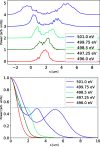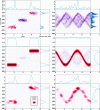Wigner distribution of self-amplified spontaneous emission free-electron laser pulses and extracting its autocorrelation
- PMID: 33399547
- PMCID: PMC7842223
- DOI: 10.1107/S160057752001382X
Wigner distribution of self-amplified spontaneous emission free-electron laser pulses and extracting its autocorrelation
Abstract
The emerging concept of `beam by design' in free-electron laser (FEL) accelerator physics aims for accurate manipulation of the electron beam to tailor spectral and temporal properties of the radiation for specific experimental purposes, such as X-ray pump/X-ray probe and multiple wavelength experiments. `Beam by design' requires fast, efficient, and detailed feedback on the spectral and temporal properties of the generated X-ray radiation. Here a simple and cost-efficient method to extract information on the longitudinal Wigner distribution function of emitted FEL pulses is proposed. The method requires only an ensemble of measured FEL spectra and is rather robust with respect to accelerator fluctuations. The method is applied to both the simulated SASE spectra with known radiation properties as well as to the SASE spectra measured at the European XFEL revealing underlying non-linear chirp of the generated radiation. In the Appendices an intuitive understanding of time-frequency representations of chirped SASE radiation is provided.
Keywords: FEL; SASE; Wigner; duration; spectrogram.
open access.
Figures


















 in the case of (a) no detrimental effects introduced, (b) added 100% pulse energy jitter, (c) 1 eV photon energy jitter and (d) convolving spectra with 0.2 eV FWHM instrumental function.
in the case of (a) no detrimental effects introduced, (b) added 100% pulse energy jitter, (c) 1 eV photon energy jitter and (d) convolving spectra with 0.2 eV FWHM instrumental function.References
-
- Agapov, I., Geloni, G., Tomin, S. & Zagorodnov, I. (2014). Nucl. Instrum. Methods Phys. Res. A, 768, 151–156.
-
- Allaria, E., Callegari, C., Cocco, D., Fawley, W. M., Kiskinova, M., Masciovecchio, C. & Parmigiani, F. (2010). New J. Phys. 12, 075002.
-
- Altarelli, M., Brinkmann, R., Chergui, M., Decking, W., Dobson, B., Düsterer, S., Grübel, G., Graeff, W., Graafsma, H., Hajdu, J., Marangos, Jonathan., Pflüger, J., Redlin, H., Riley, D., Robinson, I., Rossbach, J., Schwarz, A., Tiedtke, K., Tschentscher, T., Vartaniants, I., Wabnitz, H., Weise, H., Wichmann, R., Witte, K., Wolf, A., Wulff, M. & Yurkov, M. (2006). The European X-ray Free-Electron Laser, Technical Design Report. DESY Report 2006g-097. DESY, Hamburg, Germany.
-
- Behrens, C., Decker, F.-J., Ding, Y., Dolgashev, V. A., Frisch, J., Huang, Z., Krejcik, P., Loos, H., Lutman, A., Maxwell, T. J., Turner, J., Wang, J., Wang, M.-H., Welch, J. & Wu, J. (2014). Nat. Commun. 5, 3762. - PubMed
-
- Chapman, H. N., Fromme, P., Barty, A., White, T. A., Kirian, R. A., Aquila, A., Hunter, M. S., Schulz, J., DePonte, D. P., Weierstall, U., Doak, R. B., Maia, F. R. N. C., Martin, A. V., Schlichting, I., Lomb, L., Coppola, N., Shoeman, R. L., Epp, S. W., Hartmann, R., Rolles, D., Rudenko, A., Foucar, L., Kimmel, N., Weidenspointner, G., Holl, P., Liang, M., Barthelmess, M., Caleman, C., Boutet, S., Bogan, M. J., Krzywinski, J., Bostedt, C., Bajt, S., Gumprecht, L., Rudek, B., Erk, B., Schmidt, C., Hömke, A., Reich, C., Pietschner, D., Strüder, L., Hauser, G., Gorke, H., Ullrich, J., Herrmann, S., Schaller, G., Schopper, F., Soltau, H., Kühnel, K.-U., Messerschmidt, M., Bozek, J. D., Hau-Riege, S. P., Frank, M., Hampton, C. Y., Sierra, R. G., Starodub, D., Williams, G. J., Hajdu, J., Timneanu, N., Seibert, M. M., Andreasson, J., Rocker, A., Jönsson, O., Svenda, M., Stern, S., Nass, K., Andritschke, R., Schröter, C.-D., Krasniqi, F., Bott, M., Schmidt, K. E., Wang, X., Grotjohann, I., Holton, J. M., Barends, T. R. M., Neutze, R., Marchesini, S., Fromme, R., Schorb, S., Rupp, D., Adolph, M., Gorkhover, T., Andersson, I., Hirsemann, H., Potdevin, G., Graafsma, H., Nilsson, B. & Spence, J. C. H. (2011). Nature, 470, 73–77. - PubMed
LinkOut - more resources
Full Text Sources
Other Literature Sources

